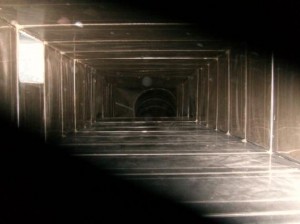 Air ducts are used to distribute air through out a building, or to exhaust air outside of a building. The most common are: sheet metal, fiberglass lined, fiberboard, and flex-line air ducts.
Air ducts are used to distribute air through out a building, or to exhaust air outside of a building. The most common are: sheet metal, fiberglass lined, fiberboard, and flex-line air ducts.
Sheet Metal Air Ducts
The most common type of ridged air duct is constructed of galvanized steel or aluminum. They may be round, rectangular, or in the form of a spiral oval. Sheet metal air ducts are the most durable type of air duct construction, and because their non-porous surface, are the least likely to have mold or biological growth.
Fiberglass Lined Air Ducts
Some sheet metal air ducts air ducts are lined with an external or internal fiberglass duct liner. Fiberglass lining is used to insulate air ducts from heat loss or to avoid condensation in cases where the supply air is very cold, or there is a high ambient humidity in the plenum. Fiberglass lining also provides sound attenuation, reducing the noise of the HVAC system.
Fiberboard Air Ducts
Fiberboard air ducts are constructed with boards of compressed resin bonded inorganic glass fibers. They have a foil face on the outside that serves as the air barrier and water vapor retarder. The interior of fiberboard air duct is sealed to prevent fiberglass fibers from entering the air stream. Fiberboard air duct also provide acoustical and thermal benefits, and are typically the most inexpensive air duct systems to install.
Flexible Air Ducts
Flexible air ducts are constructed with a spring steel wire helix, encapsulated in a 2-ply, polymer plastic. Flexible air ducts are inexpensive, lightweight, and easy to install. It is important that the lengths of the flexible air ducts be kept as short as possible as the length of flexible, and numbers bends within the flexible greatly effects system performance.

